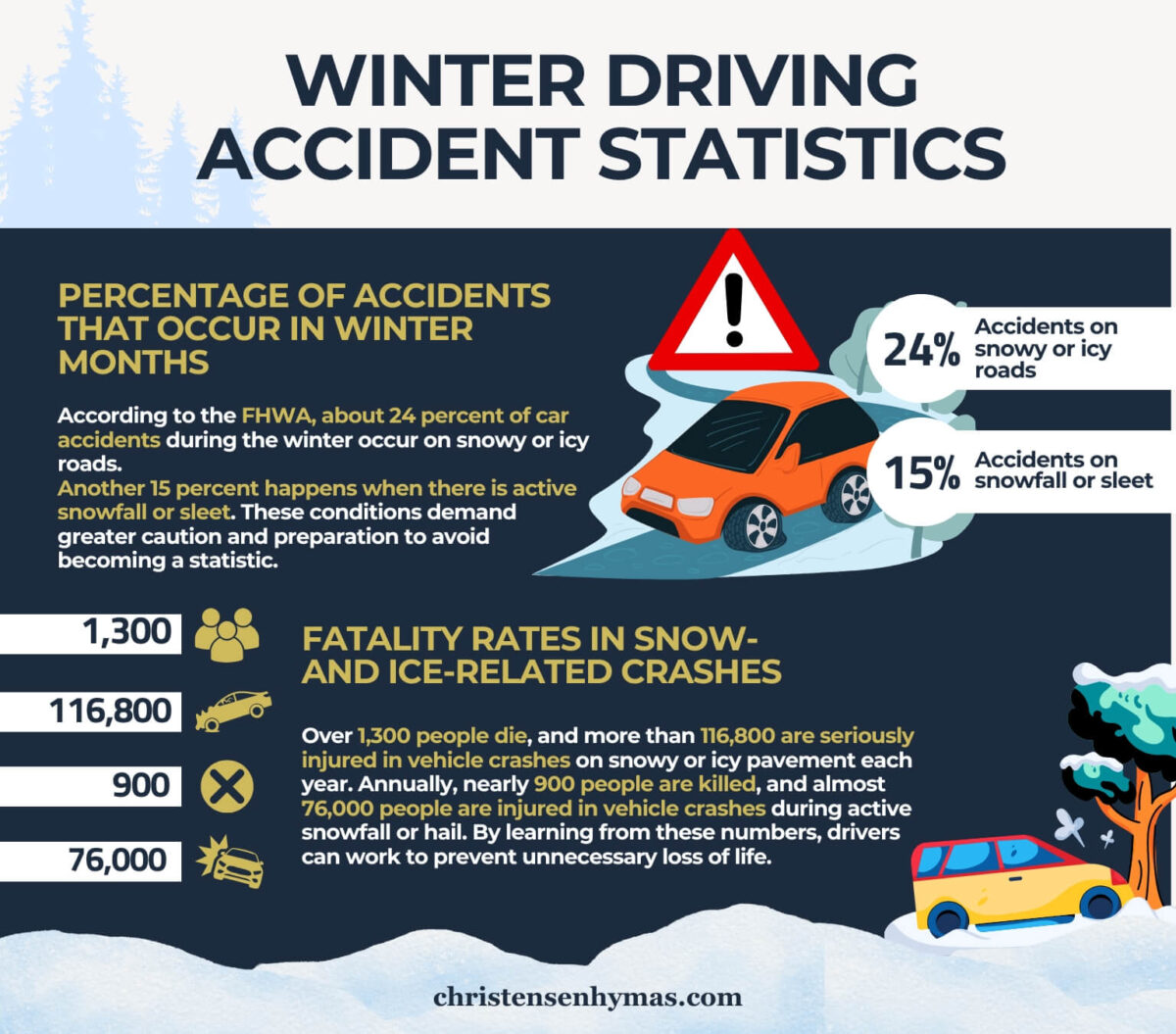
Winter driving affects people across the country, forcing them to adjust their habits and take extra precautions. Snow and ice make roads slippery, increasing the chance of a car accident and reducing the effectiveness of normal driving techniques.
According to the Federal Highway Administration (FHWA), weather-related vehicle crashes rise during the coldest months, especially in snowy regions where conditions remain harsh for extended periods. With proper preparation and awareness, drivers can lower their risks and improve their safety on icy roads. At Good Guys Injury Law, we advocate for those injured in winter car crashes.
When the winter season arrives, many drivers face inclement weather that tests their skill and patience. Wintry weather, such as heavy snow and light snow, challenges even experienced motorists and encourages slower speeds to maintain control.
State and local agencies often dispatch snow plows to clear the roads, but the danger does not vanish instantly. Take a look at some key stats and safety tips regarding winter driving below. Then, contact us to schedule a free case consultation.
Table of Contents
Winter Driving Accident Statistics

Many drivers underestimate how winter weather influences traffic safety. Icy surfaces and reduced visibility increase the number of collisions. By examining relevant data, we gain insight into how widespread and severe these crashes can become.


Looking for a Utah Car Accident Attorney? Contact Good Guys Injury Law Today!

Percentage of Accidents That Occur in Winter Months
During the winter season, a surprising share of total crashes happen due to wintry weather. Snowy roads and snowy or icy conditions raise the risk of losing control. The number of accidents often spikes when temperatures dip below freezing and roads turn slick.
According to the FHWA, about 24 percent of car accidents during the winter occur on snowy or icy roads. Another 15 percent happens when there is active snowfall or sleet. These conditions demand greater caution and preparation to avoid becoming a statistic.
Fatality Rates in Snow- and Ice-Related Crashes
Fatal crashes involving snow and ice highlight the deadly potential of bad weather. Poor visibility, reduced traction, and driver errors contribute to these tragic outcomes. Even a brief lapse in judgment can lead to deadly results on slippery roads.
Over 1,300 people die, and more than 116,800 are seriously injured in vehicle crashes on snowy or icy pavement each year. Annually, nearly 900 people are killed, and almost 76,000 people are injured in vehicle crashes during active snowfall or hail. By learning from these numbers, drivers can work to prevent unnecessary loss of life.
Common Causes of Winter Driving Accidents

Various factors fuel the spike in winter driving crashes. Some stem from the environment, while others arise from driver habits or poorly maintained vehicles. Breaking down the causes helps drivers make smarter choices. A few common causes of winter driving accidents include:
Loss of Control on Icy Roads
Icy roads reduce tire grip and increase stopping distances. Without caution, drivers skid and spin, making it harder to avoid obstacles. Maintaining proper tire pressure and following winter driving tips, such as steering gently and braking slowly, can help you maintain control. Eliminating the urge to use cruise control in icy conditions keeps the focus on manual handling.
Reduced Visibility Due to Snow and Fog
Snow and fog block your view, making spotting other vehicles or hazards tough. Under these conditions, using an ice scraper to clear windows fully becomes essential. Switching on your interior dome light sparingly can help you find items inside without glaring reflections. Slowing down and increasing the following distance grants more time to react in poor visibility.
Lack of Winter Tires
All-season tires may not provide enough traction in cold weather and snowy roads. Winter tires offer specialized tread that handles snow and black ice better. Drivers in snowy regions often notice improved stability and reduced skidding when upgrading their tires. This simple change lowers accident risk and increases confidence behind the wheel. Invest in the right tires for snowy or icy conditions.
Problems With Brakes on the Snow
Pressing the brakes too hard on slippery surfaces can cause the wheels to lock. Maintaining gentle pressure and avoiding sudden stops reduces the risk of spinning out, especially when on black ice. Modern braking systems and careful driving keep you safer in wintry weather. Remember that balanced, well-maintained brakes give you a fighting chance when the road turns slick.
Following Too Closely
Tailgating magnifies the danger in winter conditions. If the driver ahead slows unexpectedly, you have less room to react, increasing the likelihood of a crash. Keep a generous gap to allow for safer braking and maneuvering. Patience and caution go a long way in preventing needless accidents.
Overconfidence in All-Wheel Drive Vehicles
All-wheel drive improves traction when starting or climbing hills, but it does not guarantee shorter stopping distances on ice. Overconfidence leads some drivers to push their vehicles too hard, resulting in a loss of control. Even with advanced technology, adjusting your habits to the conditions remains crucial. Treat all-wheel drive as a helpful tool, not an excuse to ignore the hazards.
Impact of Winter Weather on Traffic Patterns
Winter weather changes traffic flow and creates unique patterns. Delays, collisions, and added expenses emerge as common themes. Understanding these effects helps you plan better and reduce your risks. A few key impacts of winter weather on traffic patterns include:
Increase in Traffic Delays During Snowstorms
Snowstorms slow everyone down. Heavy snow reduces visibility, making passing slower vehicles or navigating sharp turns harder. The result is gridlock, frustration, and wasted time. Planning and allowing extra travel time ease stress and reduce the chance of rash decisions.
Spike in Vehicle Collisions During First Snowfall
When the first snowfall hits, drivers often fail to adjust quickly. Lack of practice in wintry conditions leads to more collisions. Training yourself to drive differently as soon as the weather changes can prevent accidents. Early preparation and mindful adjustments separate cautious drivers from those who learn lessons the hard way.
Economic Costs of Winter Driving Accidents
Beyond personal injury, car accident costs run high. Property damage, medical bills, and lost income strain individuals and communities. Businesses suffer, too, as delays and wrecks limit productivity. Preventing accidents saves money and preserves resources.
The Key Benefits of Working With Our Team After a Winter Crash

After a crash, you need reliable support and guidance to recover and hold responsible parties accountable. Our experienced team helps you rebuild your life. A few benefits of working with our team include:
- Legal advice. We explain your rights and possible outcomes. Our skilled attorneys guide you through every step with personalized attention.
- Evidence gathering. We collect photos, witness accounts, and official reports. This strong foundation strengthens your case and supports a fair resolution.
- Negotiating with insurers. Dealing with insurance companies alone can lead to unfair offers. Our team speaks on your behalf, seeking just compensation.
- Seeking medical compensation. Injuries from a winter driving accident deserve proper care. We fight for coverage of treatments and follow-up visits.
- Maximizing financial recovery. In addition to medical costs, we pursue lost wages and other damages. Our goal is to restore balance after the crash.
With professional support, you gain confidence and peace of mind. Our help ensures you face this challenge with a reliable ally at your side. We always fight for our clients.
Reach Out To Our Utah Car Accident Attorney for a Free Case Consultation

At Good Guys Injury Law, our team understands how frustrating this situation feels and wants to help you find solutions. We know that a snow shovel is only one of many key tools you might need during winter. After a winter car accident, we are here to advocate for you. Contact us today to schedule a free case consultation.






